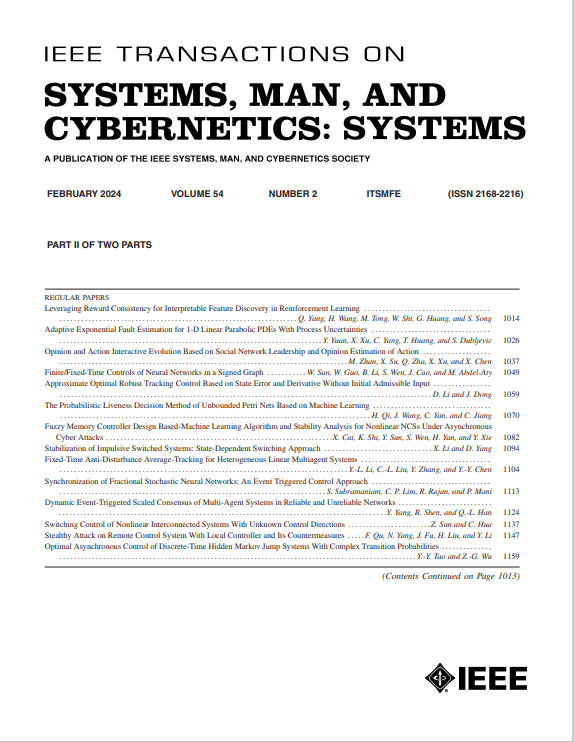Robust AI-Driven Target-Object-Free Hybrid Vision/Force Control of Industrial Robotic Systems
IF 8.6
1区 计算机科学
Q1 AUTOMATION & CONTROL SYSTEMS
IEEE Transactions on Systems Man Cybernetics-Systems
Pub Date : 2025-04-28
DOI:10.1109/TSMC.2025.3561241
引用次数: 0
Abstract
This article introduces a robust AI-driven hybrid vision/force control (HVFC) method for industrial robots. The proposed HVFC method exploits Superpoint, a pretrained deep convolutional neural network (DCNN), as the AI agent to extract interest points for image-based visual servoing (IBVS), making it a target-object-free method. This tackles the limited workspace issue of eye-in-hand robots interacting with a workpiece due to the short distance between the camera and the workpiece, including a target object or landmarks. A learning-by-demonstration (LBD) method is also developed to generate the desired interest points associated with the desired path on the workpiece for interaction. To handle the issue of a high and variable number of interest points for use in IBVS, a set of six independent image features is extracted from the detected interest points, resulting in an invertible image interaction matrix, leading to global stability and a robust control process. To perform HVFC, a hierarchical orthogonal sliding manifold is defined, allowing force control in the normal direction and IBVS in the rest. Further, a filtered terminal integral sliding-mode controller is developed to stabilize the manifold, resulting in high tracking accuracy and robust performance against uncertainties and measurement noises. The experimental results of polishing and sanding the surfaces of a flat plastic board, a wooden airplane propeller, and a metal pegboard demonstrate the feasibility and superiority of the proposed HVFC-LBD method over conventional counterparts in terms of workspace expansion, robustness, and tracking accuracy.鲁棒人工智能驱动的工业机器人系统无目标-无物体混合视觉/力控制
本文介绍了一种用于工业机器人的鲁棒人工智能驱动的混合视觉/力控制(HVFC)方法。提出的HVFC方法利用预训练的深度卷积神经网络Superpoint (DCNN)作为人工智能代理提取兴趣点用于基于图像的视觉伺服(IBVS),使其成为一种无目标对象的方法。这解决了由于相机和工件(包括目标物体或地标)之间的距离较短而导致眼手机器人与工件交互的有限工作空间问题。还开发了一种通过演示学习(LBD)的方法来生成与工件上的期望路径相关的期望兴趣点以进行交互。为了解决IBVS中使用的兴趣点数量多且多变的问题,从检测到的兴趣点中提取一组6个独立的图像特征,从而得到一个可逆的图像交互矩阵,从而实现全局稳定性和鲁棒控制过程。为了实现HVFC,定义了一个分层正交滑动流形,允许在法向的力控制和其余方向的IBVS。此外,开发了一种滤波终端积分滑模控制器来稳定流形,从而实现了高跟踪精度和抗不确定性和测量噪声的鲁棒性。通过对平面塑料板、木制飞机螺旋桨和金属钉板表面的抛光和打磨实验,验证了该方法在工作空间扩展、鲁棒性和跟踪精度方面的可行性和优越性。
本文章由计算机程序翻译,如有差异,请以英文原文为准。
求助全文
约1分钟内获得全文
求助全文
来源期刊

IEEE Transactions on Systems Man Cybernetics-Systems
AUTOMATION & CONTROL SYSTEMS-COMPUTER SCIENCE, CYBERNETICS
CiteScore
18.50
自引率
11.50%
发文量
812
审稿时长
6 months
期刊介绍:
The IEEE Transactions on Systems, Man, and Cybernetics: Systems encompasses the fields of systems engineering, covering issue formulation, analysis, and modeling throughout the systems engineering lifecycle phases. It addresses decision-making, issue interpretation, systems management, processes, and various methods such as optimization, modeling, and simulation in the development and deployment of large systems.
 求助内容:
求助内容: 应助结果提醒方式:
应助结果提醒方式:


